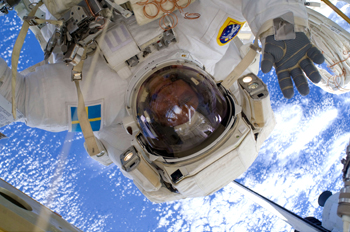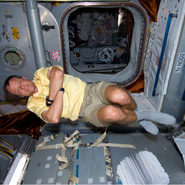Posted 21 November 2011
Irish technology to keep astronauts fit and healthy in space
A new device that stimulates the large muscles of the legs to produce aerobic exercise training and muscle strengthening effects is scheduled to be tested during a parabolic flight by the European Space Agency to see of it can solve the problem of how astronauts can exercise aerobically in the confines of a spacecraft.
The parabolic flight campaign provides an opportunity to test the novel technology in a zero gravity environment, similar to that experienced on the International Space Station.

ESA astronaut Christer Fuglesang on a space walk outside the International Space Station (Sept 2009). Credit: NASA
The Neuromuscular Electrical Muscle Stimulation Exercise technology was developed through a partnership between University College Dublin (UCD) researchers and Galway based Biomedical Research Ltd (BMR) – suppliers of electrical muscle stimulation devices for the commercial market e.g. Slendertone® and Neurotech®.
The lead on the UCD side is Dr Brian Caulfield, a senior lecturer from the UCD School of Public Health, Physiotherapy, and Population Science, and Director of TRIL (Technology Research for Independent Living), and Principal Investigator in CLARITY at UCD.
Pictured far right: ESA astronaut Christer Fuglesang, STS-128 mission specialist, is pictured floating freely in the Leonardo Multi-Purpose Logistics Module (MPLM), temporarily attached to the International Space Station while Space Shuttle Discovery remains docked with the station (Sept 1999). Credits: NASA
“Keeping in shape is always important, but working out in space is even more crucial in order to counteract the detrimental effects of weightlessness,” said ESA astronaut Christer Fuglesang, who is Head of Science & Applications Division in ESA’s Human Spaceflight & Operation Directorate.
“We still have a lot to learn about how the body reacts in space and find the best methods to keep astronauts fit, also when returning to Earth. I'm very pleased that researchers in Ireland are actively participating in this important field, which eventually will help us to send humans all the way to Mars”.
UCD’s Dr Caulfield is one of two Irish researchers who have been awarded contracts by the European Space Agency which were announced by Minister for Research & Innovation Seán Sherlock TD. Dr Dónal O’Gorman from Dublin City University was also awarded a contract.
The contracts arise directly from Ireland’s membership of ESA and its Space Programme. Ireland’s membership of ESA is funded by the Irish Government and is managed by Enterprise Ireland. Membership of ESA enables Irish research institutes and companies to participate in ESA programmes and secure valuable contracts.
Congratulating the researchers, Minister Sherlock said:
“The awarding of ESA contracts to Irish researchers is further evidence of the leading role Ireland plays in pushing the boundaries of biomedical research for the European Human Spaceflight programme.
“We are seeing a growing number of Irish companies developing biomedical technologies with ESA support, which contributes to employment generation in Ireland and which can also benefit society here on Earth. The ESA space-related research in Ireland builds on the strategic investments that the Government has made in life sciences in the past decade through Enterprise Ireland and Science Foundation Ireland.”
Dr Bryan Rodgers, Enterprise Ireland explained why this research is so important:
"Astronauts can be in space for up to 18 months on missions to Mars and on board the International Space Station and so they have to adapt to the specific challenges of life in space such as the absence of gravity, high levels of radiation, and cramped living conditions, which often result in deterioration of the astronauts’ heart, muscle and bone condition."
“The research of Dr. Caulfield and Dr O’Gorman will address these issues and find solutions to enable astronauts to function healthily on critical missions. This research also has applications in the healthcare markets back here on Earth, as the characteristics of natural human aging are similar to those experienced by astronauts”.
The ESA funding is provided through two programmes - ELIPS (European programme for life and physical sciences in space) and PRODEX (Programme de dévelopement d'expériences scientifiques). Enterprise Ireland manages Ireland’s membership of the European Space Agency which allows Irish researchers to access microgravity test services including parabolic flights and bed rest facilities.
About ELIPS and PRODEX
ELIPS is the European programme for LIfe and Physical sciences in Space. The ELIPS programme is intended to prepare and perform research on the International Space Station (ISS) and other carriers such as sounding rockets and unmanned orbital vehicles, in fundamental and applied Life and Physical sciences. ELIPS is an indispensable programme to ensure that Europe’s investment in the development and exploitation of the ISS produces the best scientific results. Applications of research in space will find its way into new medical techniques, industrial innovations and environmental technologies, for the general benefit of Earth’s population.
PRODEX stands for the PROgramme de Développement d'EXpériences scientifiques. Through Enterprise Ireland, Irish research institutes have been enabled to participate in PRODEX since 1987, developing scientific instruments and experiments for ESA missions. Since then, Irish researchers have made significant contributions in ESA’s science, microgravity and earth observation programmes.
About Christer Fuglesang
Christer Fuglesang, of ESA, is the first astronaut from Sweden, and has participated in two missions to the International Space Station, including five space walks. He has held positions as Senior Fellow at CERN, and as an Affiliate Professor at the Royal Institute of Technology (KTH), Stockholm. He is currently Head of Science & Applications Division in the Human Spaceflight & Operations Directorate at the European Space Agency’s research technical centre in Noordwijk, The Netherlands.
(Produced by UCD University Relations)

